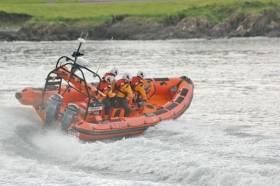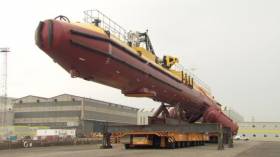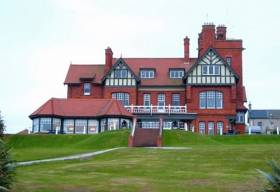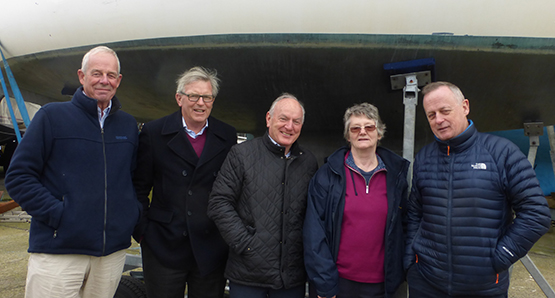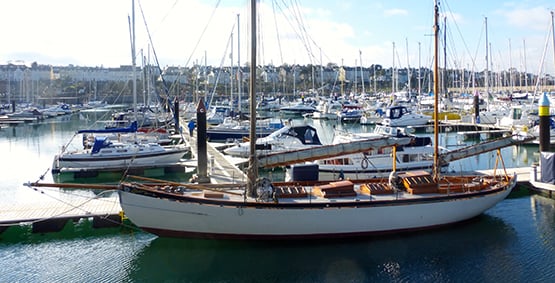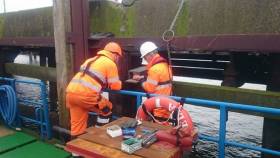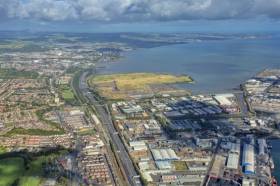Displaying items by tag: Belfast Lough
#RecordPerformance -Turnover at Belfast Harbour, which handles 70% of Northern Ireland’s seaborne trade and 20% of the entire island’s, rose by 3.4% to £54.3m. According to the annual report for 2015, operating profit also increased by 3.4% to stand at £28.7m. Profits before Tax rose 2.3% to £29.9m.
The report also contained details of infrastructure projects completed during the financial year totaling £18 million – up almost 40% on the previous year – and new projects totaling £100 million which are either underway or due to commence within the next six months.
Commenting on the results Dr. David Dobbin, Belfast Harbour’s Chairman said: “This has been an excellent trading year for Belfast Harbour with 23 million tonnes of cargo being handled by the Port during 2015. We’re also pleased to report on the completion and progress of a number of ambitious investments which are driving the ongoing regeneration of Belfast Harbour Estate.
“Our role is to continue to manage, maintain and develop the resources of the Harbour, and optimize outcomes for our customers and the wider regional economy. All of our earnings are re-invested in projects such as improved container and quayside handling facilities, dockside cranes or the award-winning City Quays Grade ‘A’ office development. Work is also well underway on our new film studios and we hope to announce a contractor and brand operator for a new hotel at City Quays within the coming weeks.
“These investments are resulting in new jobs and improved regional competitiveness. Belfast Harbour is committed to helping the Northern Ireland economy grow and prosper.”
2015 was the second busiest year on record for imports and exports through Belfast Harbour, reflecting its long-term policy of developing best-in-class marine facilities. This included the purchase and order of two modern pilot boats, improved Roll-On / Roll-Off handling facilities and improved bulk storage capacity for customers operating in the salt and fertiliser sectors.
Property developments progressed by Belfast Harbour included the completion of City Quays 1 (now fully let to high calibre international occupiers), the commencement of work on its 124,000 sq ft sister office, the securing of planning for a four-star hotel at City Quays and the start of work this year on a new 130,000 sq ft film studio.
Dr. Dobbin added: “The landscape of Belfast Harbour is being transformed as new marine and real estate developments come to fruition. With £100 million committed to projects which are already underway, or are in the process of securing planning such as the proposed new cruise berth, we are laying the foundations for how Belfast Harbour will look and feel for the 21st Century.
“Trade in the first quarter of 2016 has already shown encouraging signs of growth, building upon the success of our customers and the outward looking ethos of Northern Ireland’s private sector. Our expectation is that such growth will enable the Harbour to continue to support and self-fund its ambitious investment programme, creating much needed quality jobs.”
The report highlighted continued growth in Belfast’s main routes to Scotland and England with the Belfast – Liverpool Stena service recording the strongest performance with a 4% increase.
Preparatory work on a new coal processing plant also continued and the Harbour provided leases to Titanic Foundation Ltd to facilitate the restoration and conversion of the former Harland & Wolff headquarters building in Titanic Quarter into a boutique hotel.
Added to this writes Afloat is the city's newest major maritime visitor attraction the restored and unique HMS Caroline. The battle-cruiser is the last surviving ship of the 1916 Battle of Jutland.
#RNLI - Bangor RNLI assisted four people who got into difficulty on a broken-down motorboat on Belfast Lough on Monday evening (13 June).
The volunteer lifeboat crew launched at 10.25pm to rescue the 19ft motorboat just off the Cloghan Jetty.
The boat, with four people on board, had lost all power and was drifting in fog close to the shore.
Arriving at the scene, guided only by the light from a mobile phone, the crew of the relief Bangor lifeboat Tabby Cat took the motorboat under its control and returned it and its and crew safely to Carrickfergus Marina.
Speaking following the callout, Bangor RNLI helm Peter Semple said: :The crew and I are delighted that we were able to return these people to the safety of the marina. Although it was a calm night, it was dark, and Belfast Lough is not a great place to be if you can’t be seen.
"It is important to ensure that, if you lose all power you still have some way of being seen and making contact with the shore."
In other news from Bangor, the lifeboat station was recently visited by a man rescued a fortnight ago by one of its volunteers after he suffered a heart attack at sea.
Tim Bailie was on a weekend pleasure cruise between Carrickfergus and Bangor with his family at the end of May when he was taken ill.
But thanks to the quick action of helm Kyle Edwards and his crew, Bailie is still here to tell the tale in his own words, as per the video below:
#WorldsLargest - The world's most powerful tidal energy turbine writes the BBC News was assembled at Harland and Wolff shipyard in Belfast.
One of the yard's cranes, Goliath, will lower the 520-tonne structure into Belfast Lough today, Wednesday.
Each of the its twin rotor arms produces 1 megawatt of energy - enough to power thousands of homes when connected to the electricity grid.
After trials in the lough, the turbine will be used off the Orkney Islands.
The 75-metre long structure has taken a year to put together.
It will float on the water with the rotors dropped below the surface.
#BelfastLough - Work has already begun on a major new film studio lot on the shores of Belfast Lough.
According to the Belfast Telegraph, Belfast-based RPP Architects are drawing up plans for the North Foreshore Film Studios located at Giant's Park on the waterfront.
Newry firm O'Hare & McGovern has been contracted to construct the £20 million (€25.7 million) project that will comprise a sound stage and two studios with production offices.
As previously reported on Afloat.ie, the development aims to capitalise on Northern Ireland's increasing popularity as a filming location for films and TV series – most notably the worldwide hit Game of Thrones.
The Belfast Telegraph has much more on the story HERE.
Bangor Lifeboat Aids Fishermen After Engine Failure
#RNLI - Bangor RNLI’s volunteer lifeboat crew were requested by Belfast Coastguard to help two fishermen on a 17ft motorboat with engine failure.
Although conditions were calm and the crew were in no immediate danger, the westerly wind was extremely cold and blowing the fishing boat offshore.
The call to lifeboat operations manager Kevin Byers came in at 5.06pm yesterday evening (29 March) and the lifeboat launched at 5.15pm.
The lifeboat made its way to the reported position to the south of the Gobbins outside Belfast Lough, only to find the boat wasn’t there, and they were only able to locate it by radioing the boat for a position update.
On arrival, the volunteer lifeboat crew made sure the boat and crew were sound, and towed the boat to Carrickfergus Harbour, where they were thanked by an extremely grateful skipper.
Helming Tabby Cat, the temporary replacement for Bangor's regular lifeboat Jessie Hillyard, Bangor RNLI crewmember Gareth Whan said: “An incident like this emphasises the importance of good engine maintenance, particularly as many boats have been unused over the winter months.
“It also demonstrates the importance of warm clothing, as the crew of the rescued boat were extremely cold by the time we reached them – it is always much cooler on the water than it is on dry land.”
Royal Ulster Yacht Club Celebrates 150 Years of Sailing
In 2016, Royal Ulster Yacht Club is celebrating the 150th Anniversary of its formation in 1866. To mark the anniversary there will be a series of sailing and cruising events throughout the summer.
The important date was highlighted by WM Nixon last Saturday in his Afloat blog Belfast Lough Celebrates 150 Years of Organised Sailing in Style
The main focus of the year’s celebrations is around the end of June starting with the UK and Ireland National Championships of the Sigma 33 Class of yachts (17th-19th June). This event will attract sailors from around Ireland, Scotland, Isle of Man and North West England and Wales.
The following weekend the Club is running its Annual Regatta along with a Keelboat Weekend Event. The Annual Regatta is the flagship event in the club’s year and this year it will include visiting boats from Scotland, Dublin Bay and Strangford Lough to race alongside the competitors from the other yacht clubs in Belfast Lough. The day will start with a Sail Past in front of the Clubhouse and a naval Guardship will be in attendance. The visiting boats will include modern racing craft and classic boats such as the River and Glen classes from Strangford Lough some of which started life competing at Royal Ulster YC over 90 years ago. We are also expecting that several of the classic Howth 17 classes will travel north for our event.
The cruising fleet will be joining forces with similar associations such as the Irish Cruising Club and the Clyde Cruising Club for a social gathering before a cruise-in-company to Scottish waters.
The social highlight of the celebrations will be a Black Tie Gala Dinner at the Club on 1st July.
Belfast Lough Celebrates 150 Years of Organised Sailing in Style
The development of organised sailing in Ireland seems to have spread northeastwards from the south and southwest coasts. Although the great chieftain Hugh Maguire had a fleet of pleasure vessels including sailing craft on Lough Erne in County Fermanagh in the 1500s, while the noted scientific polymath Sir William Petty found a sailing “pleasure boatte” on Dublin Bay to test his catamaran Simon & Jude against in 1663, it was on Cork Harbour that we find the first formal organisation with the foundation of the Water Club in 1720 writes W M Nixon.
Before the advent of good roads, and long before the railways arrived, Ireland’s myriad waterways and lakes provided the best options for the inland transport both of goods and people, and inevitably some gentrifried working boats were also used for relaxation, and the next club to be formed was Lough Ree YC in 1770. By 1820, the world’s first club specifically organised to provide racing came into being on Lough Erne, then nearby on Lough Gill in Sligo, the Ladies’ Cup was first raced for in 1822, and it still is cometed for today, though now at Sligo YC’s sea base at Rosses Point.
In the pre-famine era before 1845, the relative affluence of the west and southwest of Ireland supported the landed classes in yacht ownership, and a regatta at Kilrush in the Shannon Estuary in 1828 saw the establishment of the Royal Western of Ireland YC, which at its height in 1838 had a fine fleet of 18 cutters – some of quite substantial size - based in Kilrush Creek and spreading outwards to families along the coast such as the O’Connells of Tralee, Cahirsiveen and Derrynane.

The Game Changer. Dun Laoghaire’s first regatta in 1828 set Dublin Bay on course to be the pace-setter in yachting development.
But 1828 also saw the first regatta to be staged at the new harbour of Kingstown on Dublin Bay, and the success of this provided an unrivalled focus for the development of new ideas in sailing not only in Ireland, but at an international level. Whereas other sailing area saw the locations of activity spread across several centres large and small, in Dublin Bay there was just this one big powerhouse of sailing development through which all the recreational nautical energy of the capital city was channeled. The Royal Irish YC came into being in 1831, the Royal St George YC got going in 1838, and soon Kingstown outstripped most comparable centres at home and abroad, particularly in racing development.
Yet at this time Belfast was already the fastest-expanding city in Ireland, and it was moreover a growing centre of genuine wealth-creating manufacturing industries and ship-building enterprises. Why wasn’t Belfast Lough in the forefront of sailing development by the 1850s?
It wasn’t as though there wasn’t a small but time-honoured local recreational sailing tradition on Belfast Lough. During the 1780s and 1790s, Belfast had been a place of liberal ideas and social innovation, and a small group of recreational sailors led by Henry Joy McCracken pioneered cruising from Belfast Lough to the west coast of Scotland and the Hebrides. But then in 1798 McCracken also led the rising of the United Irishmen, and when it was suppressed he was executed by hanging in the Cornmarket in Belfast on land which his grandfather had donated to the town.
Subsequently, the Presbyterian majority in the north turned in on themselves and concentrated on commerce and manufacture and literally minding their own business. But though, as prosperity returned, a small group of McCracken’s former shipmates formed the Northern Yacht Club in Belfast Lough in 1824, Belfast’s rapid industrial expansion made the port very limited as a yacht harbour, thereby limiting their growth.
Belfast Lough may have provided splendid sailing water, but it was very poorly served by other smaller harbours, so the Northern Yacht Club members often found themselves sailing to the more congenial and well-serviced shores of the Firth of Clyde. They soon formed a Scottish branch, and by 1838 the Royal Northern Yacht Club - as it was to become, with an impressive clubhouse in Rothesay - had taken over the few remaining assets of the Belfast Lough branch, and that was the end of any club in the Lough for another quarter century.
Yet any student of sailing history will know that in 1856, Lord Dufferin from Clandeboye near Bangor on the shores of Belfast Lough made a celebrated voyage to the high Arctic with his schooner Foam. And in 1865, one of the most successful racing schooners of all time, the 99ft Egeria, was built for leading Belfast linen manufacturing magnate John Mulholland. So why wasn’t Belfast Lough sharing the sailing fame of other Irish centres such as Dublin Bay and Cork Harbour, which had shown their pre-eminence by staging the world’s first recognisably modern offshore race from Dublin Bay to Cork Harbour in 1860?
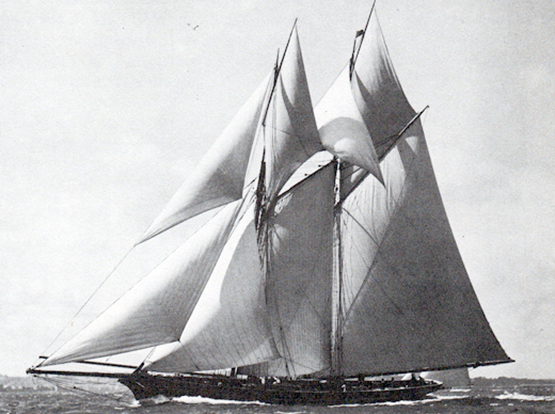
The extremely successful racing schooner Egeria was built for Belfast business magnate John Mulholland in 1865, but she was seldom if ever in Belfast Lough
The simple answer seems to be that in its period of hyper-growth, the business of Belfast was business, and sailing for recreation was not a Belfast business. Those who expected to sail at the highest level did so elsewhere, and once the Belfast to Dublin railway had been connected in 1855, it was as handy for the more affluent would-be yachtsmen to avail of the proper facilities in Dublin Bay rather than risk their yachts on exposed moorings in Belfast Lough, where shore facilities were still woefully lacking.
But in time the rapid rise of an energetic middle class in Belfast saw increasing demand for sailing amenities and events nearer home. We know that a regatta of some sort was staged at Holywood immediately east of Belfast on the lough’s south shore in 1854, and it was at Holywood – despite the little town’s drying anchorage – that the first club since the Northern YC in 1824, the Hoywood Yacht Club – was formed in 1862, and it still exists, Belfast Lough’s senior club.
Then in 1866 a regatta was staged from the only half decent harbour on the lough, at Carrickfergus, and the organisers were pleasantly surprised by the number of boats which turned out, boats whose owners had squirrelled out bits of shelter for their craft in small places like Donaghadee, Groomsport, the tiny drying harbour at Bangor, in the open roadstead off Cultra, in the cleaner parts of Belfast docks, in Carrickfergus itself, and round the corner in Larne Lough.
From this there immediately emerged the Carrickfergus Amateur Rowing & Sailing Club, but mostly to cater for local demand. But soon afterwards in Belfast the Ulster Yacht Club was formed by a group of affluent businessmen, professionals, industrialists and landowners with Lord Dufferin as their Commodore. By 1869 he’d seen to it that they’d become the Royal Ulster Yacht Club, but it was an organisation which was resolutely to function without a clubhouse until 1899, nevertheless growing in prestige with every passing year.
Thanks to that focus of interest through the Carrickfergus Regatta of 1866, 2016 will see double celebrations on Belfast Lough with the 150th Anniversaries of both Carrickfergus Amateur Rowing and Sailing Club (which everyone knows as Carrick Sailing Club), and the Royal Ulster Yacht Club, which since April 1899 has been based in an impressive Arts & Crafts clubhouse on an eminence above Bangor’s waterfront.

The RUYC clubhouse was built in 18 months and opened in 1899 in order to be ready for Thomas Lipton’s first America’s Cup campaign
When the clubhouse was built, the harbour at Bangor was still rudimentary, but the sailing was great. However, since 1984 Bangor Bay has been turned into one of Ireland’s largest marinas, and now RUYC has the berthing facilities and the sailing water to stage major events with confidence.

Befast Lough provides excellent sailing water, but until the marina were built at Carrickfergus and Bangor, it lacked sheltered berthing

Carrickfergus Marina, with the harbour and its famous 12th Century castle beyond
Equally at Carrickfergus they also have a marina – in fact it pre-dates the one at Bangor – but as Carrickfergus was also the base of the extraordinarily productive yachtbuilder John Hilditch, albeit only from 1889 to 1913, one of the main parts of their celebration is going to be a Hilditch Regatta, not just for boats built by him such as Hal Sisk’s famous 1894 Watson cutter Peggy Bawn, the Howth 17s of 1898, and the RNIYC Fairy Class of 1901, but indeed for any classic or traditional craft, as Carrick has always been a spiritual home for the Old Gaffers Association.

Bangor Marina, with Ballyholme Bay beyond
Royal Ulster has meanwhile taken a different track through sailing history, for between 1899 and 1931, it was the club through which Thomas Lipton made his five America’s Cup Challenges, which has tended to obscure the fact that in the 1880s and 1890s, Belfast Lough with RUYC in a key role were setting a fantastic pace in sailing development, as they were trying to get a one design keelboat class going as long ago as 1889, and by 1895 they’d brought the Belfast Lough One Design Association into being with a determined young sailing man called James Craig as Honorary Secretary. Membership of the BLODA was open to any member of one of the recognised six clubs now based round the lough, but young Craig – who later went on to become Lord Craigavon, first Prime Minister of Northern Ireland in 1921 – was realistic in his expectations for the life of a strict one design keelboat class, and he only expected his members to be “in class” for three seasons.
By 1896 they’d the first two boats of a new 15ft LWL keelboat class designed by William Fife, no less, sailing on Belfast Lough, and before the summer was out the signs were good for a significant increase in numbers for 1897. James Craig was insisting the boats be built by John Hilditch, as he was noted for sticking strictly to the plans as drawn by the designer, whereas the builder of the first two boats for 1896, Paddy McKeown in the heart of Belfast, was always trying to improve on the designs, even if they were from Fife.

Regatta day for the Dublin Bay 25s – their design was inspired by the Befast Lough Class I boats.
But events overtook the programme. A group of affluent Belfast Lough movers and shakers decided they certainly wanted a One-Design class to the Belfast Lough ODA rules and designed by William Fife, but they wanted a proper sea-going boats with a cabin, around 37ft in hull overall length, and 25ft on the waterline, and setting a proper gaff rig with a jackard topsail rather than the modest little gunter rig set by the 15ft LWL boats, which were still referred to as Class I.
But as the idea for the bigger boats gained traction, they became Class I, and for a while the 15ft LWL boats became Class II, but after 1900 they were Class III when a 20ft LWL class came along. But meanwhile in late 1896 and early 1897, the Hilditch yard went mad, building nine of the new 25ft LWL boats. Even Lord Dufferin and his friends Lord de Ros and Lord Bangor came round from County Down in April 1897 to the tough town of Carrickfergus to see this remarkable new class of boats being built. And once the 25 footer had their first race off Carrickfergus on May 29th , they swung into action with what today would be called a series of promotional tours, as they did all of Clyde Fortnight after a stormy crossing of the North Channel, and then after being back in Belfast Lough for long enough to race the RUYC regatta, they headed south to Dublin Bay in late July and inspired the creation of the Dublin Bay 25 class.
1898 was when they were in their prime, and by 1899 some owners were aready invoking the “three season” rule to move on, but in fact the class continued to race actively – though sometimes with very depleted numbers – on Belfast Lough until the end of the 1909 season.

John Hilditch was very busy in 1897 – in addition to the Belfast Lough Class I boats, his yard also built this 56ft motoryacht Romance for A J Lepper, for whom he’d built Peggy Bawn in 1894.
We get some idea of the boat-building pace around Carrickfergus in the late 1890s when we realise that in 1897 John Hilditch and his men were also building a 57ft Dixon Kemp motor-yacht, the Romance, for A J Lepper, for whom they’d built Peggy Bawn so well in 1894, and no sooner was the Romance out of the way than they turned to the next job, the building of the first five Howth 17s which their owners were able to sail the 90 miles to their home port in April 1898.
So obviously there’s going to be quite a complicated programme around Belfast Lough in late June and early July this year. And as the Howth 17s are in the unique position of being a Hilditch class which is not Belfast Lough-based, they hope to be able to pay their respects at Carickfergus both to the memory of their builder and to the 150th Anniversary of the Carrickfergus club, while also being able to do full justice to the Classic One Designs Regatta, which RUYC will be staging from Friday June 24th to Sunday June 26th.
The Hilditch Regatta meanwhile is from the evening of Wednesday June 22nd to Saturday June 23rd, when the fleet heads from Carrickferus to Bangor for a sail-past as part of the Royal Ulster events, but with some of the Old Gaffers then returning to Carrick (after due celebrations in Bangor) as the Carrick event is seen partially as a follow-on to the Portaferry Sails & Sounds the previous weekend, which is very much an Old Gaffers event.
In Carrickfergus are (left to right) Nick Massey, Roddy Cooper, Tom Houlihan, CSC Commodore Wendy Moore, and Ian Malcolm. Photo: W M Nixon
But for classes like the Howth 17s, despite their antiquity proper racing is what it’s all about, so I tagged along with a reconnaissance group of Howth 17 eminences when they went up North to suss out the scene this week. And as the group included Nick Massey who re-energised the class when it was going through a flakey period in 1972, Ian Malcolm who is playing a key role in the class’s current revival such that they’ll have eighteen boats racing this year, Roddy Cooper who owns the Hilditch-built Leila, and Class Captain Dr Tom Houlihan, you can be quite sure there wasn’t a dull moment.
First call was with Wendy Moore at Carrickfergus, where she’s Commodore for the 150th as the club settle into the new clubhouse after a disastrous fire three years ago, and as she’s also the Marina/Boatyard Manager and the newest addition to the ranks of owners in the local thriving Ruffian 23 class, everyone was on the same wavelength.

You’ll always find it’s now in a carpark….Roddy Cooper and Ian Malcolm stand on the spot where their Howth 17s Leila and Aura were built in 1898, with Carrickfergus Castle in the background. Photo: W M Nixon
Then we swung by Royal North of Ireland Yacht Club at Cultra on the south shore of the lough, home to the Hilditch-built Fairy class against whom the Howth crowd regularly have inter-club races, and fortuitously met up with Northern Ireland Old Gaffers Association Chairman Gary Lyons for some very high-powered info exchange. As a result we round out this week’s blog with a photo which does justice to the Portaferry Sails & Sounds which he is organising in June.
Then on in haste for a sailing business lunch (delicious) at Royal Ulster YC with Vice Commodore Myles Lindsay, Rear Commodore Greg Taylor, Honorary Sailing Secretary Robin McKelvey and Press Officer Fiona Hicks, learning yet again that the RUYC clubhouse is such a store of sailing memorabilia that it’s a difffcult to concentrate on the formal agenda, but I think the Howth men and the Bangor men understood each other very well indeed.

Myles Lindsay, Vice Commodore RUYC

Robin McKelvey, Honorary Sailing Secretary RUYC
The RUYC people have a lot on their plate, for no sooner is the Classics Regatta out of the way than they gear up at the beginning of July for an assembly in Bangor of cruising boats from the ICC, the RCC, the OCC, the CCC and other associated organisations, followed by a 150th Anniversary Cruise-in-Company along the Antrim coast and on to the West Coast of Scotland and the Hebrides.
But for the recce group from Howth, now it was down to Bangor Marina where manager Kevin Baird couldn’t have been more obliging, but the Howth 17 men all fell in love with the classic ketch Morna berthed right next to the marina office, so Fiona and I had to speed them on their way to the exhibition of 150 Years of sailing in Bangor Museum.
The classic ketch Morna in Bangor Marina. Photo: W M Nixon
And then after that, duty done and work completed, I took them for the treat of the day, down among the hidden places of Strangford Lough to meet up with Kenny Smyth at his boatyard, which for any one who is into classic, vintage or traditional boats is heaven on earth. And of course it emerged that Kenny the King of the River Class, Whiterock’s historic Mylne-designed premier fleet, has recently become Commodore of Strangford Lough Yacht Club. So we headed for home into a gorgeous sunset having notched up two Commodores, one Vice Commodore, one Rear Commodore, one Chairman, one Honorary Sailing Secretary, two Marina Managers and one Press Officer. And if that’s not a good day’s work on the diplomacy and negotiating front, then I don’t know what is.
The eternal enthusiast. Kenny Smyth of Whiterock runs a boatyard, he is also Commodore of Strangford Lough Yacht Club, he is River Class champion, and he just loves talking about boats night and day. Photo: W M Nixon
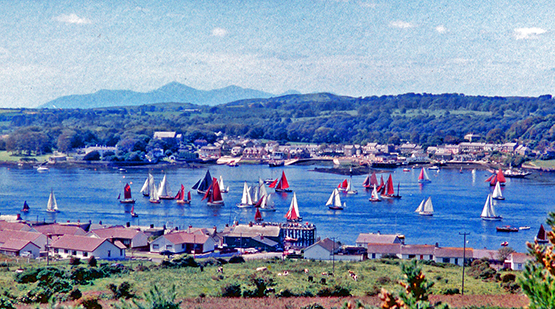
The promise of summer – the classic and traditional season in the north starts with Portaferry Sails and Sounds on June 16th.
New Waterside 'Apartments' For Special Belfast Lough Residents
#BelfastLough - Belfast Harbour has announced the completion of its latest waterside apartments - but you may have to look close to see them, as they were created for some very special residents.
Indeed, as you can see from the tweet below, the wooden nesting boxes installed beneath a harbour pier are just the right size for the harbour's nesting guillemots.
Here's to a happy new home for some of Belfast's most striking marine wildlife!
Construction just finished on our new waterside apartments. Created for v special residents-the Harbour's Guillemots pic.twitter.com/LrJYpWR5cF
— Belfast Harbour (@BelfastHarbour) March 15, 2016
#BelfastLough - Giant's Park on the North Foreshore of Belfast Lough is set to be the location of a new film studio, according to BBC News.
The circa £14 million development aims to capitalise on Northern Ireland's increasing popularity as a filming location for hit TV series like Game of Thrones and films such as the Brad Pitt-produced The Lost City of Z.
Belfast City Council heard that hundreds of jobs could be created in the construction and operation of the studio, earmarked for the former landfill waterfront site.
In other news, a 19th-century chapel overlooking Giant's Park with stunning views over Belfast Lough is on the market as part of a 'unique' residential development.
Built by the third Marquis of Donegall in the mid-1800s, the former Chapel of the Resurrection was extensively renovated in the 1980s and is now part of a package of zoned housing lands in a very desirable part of North Belfast, as the Belfast Telegraph reports.
Historic Belfast Lough Boatyard Lives On Through Classic Yachts
The recreational marine industry is a demanding trade. Your customers buy boats for pleasure, so they assume it’s a fun business to work in. Thus there’s no lack of potential boat designers and builders to be found among the children of those who only sail for sport and fun, for they see that the adults enjoy being around boats, and they get to think that being around boats all the time for work and play is the only way to live.
But in the end, business is business. The bottom line rules everything else. However enthusiastic young people may have been when first going into the boat trade, as they battle on with running their own marine business they find the world of commerce can become a cruel place. W M Nixon considers the challenges of boat-building, and looks at the story of John Hilditch of Carrickfergus, who was one of the brightest stars of the Irish boat-building industry in the golden age of yachting, yet his light was extinguished after barely two decades.
The name of Hilditch of Carrickfergus is synonymous with classic yachts of significant age. John Hilditch built the 36ft G L Watson-designed cutter Peggy Bawn in 1894, and she still sails. In fact, she sails in better shape than ever, as she had a meticulous restoration completed for Hal Sisk of Dun Laoghaire in 2005.
More recently, in 2013 the Hilditch-built Mylne-designed Belfast Lough Island Class 39ft yawl Trasnagh was restored for Ian Terblanche in Devon in time for her Centenary. And in 2015, the Belfast Lough OD Class I Tern – 37.5ft LOA to a William Fife design and built in 1897 with seven sister-ships by John Hilditch - has appeared in Mallorca so superbly restored that when she went on to Les Voiles de St Tropez at the end of September, she won her class despite it being heavy weather, and she only just out of the box.
 Peggy Bawn in her first season afloat in 1894. She was built for A J A Lepper, Commodore of Carrickfergus Sailing Club, who was one of John Hilditch’s most loyal clients. Photo courtesy RUYC
Peggy Bawn in her first season afloat in 1894. She was built for A J A Lepper, Commodore of Carrickfergus Sailing Club, who was one of John Hilditch’s most loyal clients. Photo courtesy RUYC
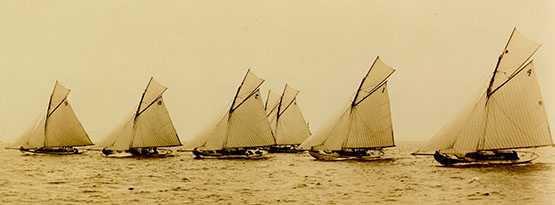
A monumental achievement. All the boats of the new Fife-designed Belfast Lough OD Class 1 of 1897 were built by John Hilditch in less than a year. Photo: Courtesy RUYC
But we don’t have to go to distant restoration specialists to find evidence of the large and varied Hilditch output. The first five boats of the Howth 17 OD class were built by John Hilditch immediately after he’d built the eight Belfast Lough Class I boats. The little new Howth gaff sloops – rigged with huge jackyard topsails as they still are today - sailed the 90 miles home down the Irish Sea to Howth in April 1898, and had their first race on May 4th 1898. All five of the original Hilditch creations continue to race with the thriving Howth 17 class, which today has eighteen boats.
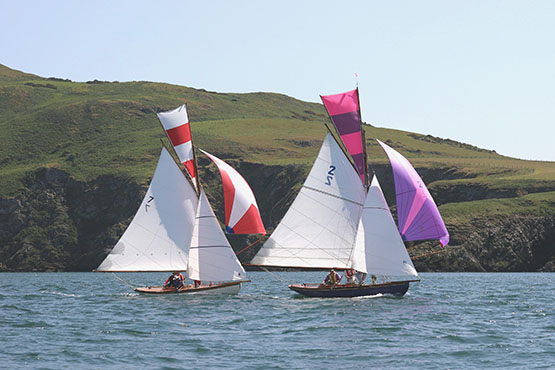
The Howth 17s Aura (left) and Pauline. Aura is one of the original five Howth 17s built for 1898 by John Hilditch immediately after he had completed the Belfast Lough Class I boats. Photo: John Deane
This concentration of yacht design development in a short time span, and through just one boatyard, is rare but not unique – the great name of Charlie Sibbick of Cowes shone equally briefly but even more brightly at much the same time, as he was a designer too. But Sibbick made his name in an established international centre for sailing. Yet when John Hilditch – who was both a seafarer and a fully-qualified shipwright – established his yard at Carrickfergus on Belfast Lough in the winter of 1892-93, the north of Ireland was still a relative backwater in international sailing terms. Thus his achievement is indeed remarkable. For by the time Hilditch closed down in the winter of 1913-14, he had put Belfast Lough firmly in the global picture as a pace-setter in yacht development, and his pivotal role in that transformation is gaining increasing recognition.
Not that there hadn’t been sailing in Belfast Lough before Hilditch came along. There are many yacht and sailing clubs around this fine stretch of sailing water, and the most senior of them is Holywood Yacht Club (on the waterfront below the hills where Rory McIlroy learned to pay golf), which dates back to 1862. And in 1866, two more new clubs came into being – Carrickfergus Sailing Club which was obviously location-specific, and the Ulster Yacht Cub, which became the Royal Ulster Yacht Club in 1869, but was a premises-free moveable feast until 1898, when America’s Cup challenger Thomas Lipton insisted it have a clubhouse, which was duly opened on an eminence close above the Bangor waterfront in April 1899.
The shared foundation year which goes back through the mists of time to 1866 means that both clubs will be celebrating their 150th Anniversaries in 2016. They’ve been quietly working on their separate plans towards celebrating this significant date, with a massive new history of the RUYC under way for a couple of years now and due for publication in the Spring, while Carrickfergus also has plans in the publication line.
Yet although there is much to write about now, in both club’s cases the pace of development was relatively slow until the late 1880s, for until that time, the business of the rapidly expanding city of Belfast was business, and more business. It wasn’t until the 1880s that leisure sailing began to get serious attention from the rapidly growing middle classes of the greater Belfast area. But once they did begin to take it up, they did so with complete enthusiasm, and the sailing pace of Belfast Lough during the 1890s, and on towards 1910, had few rivals.
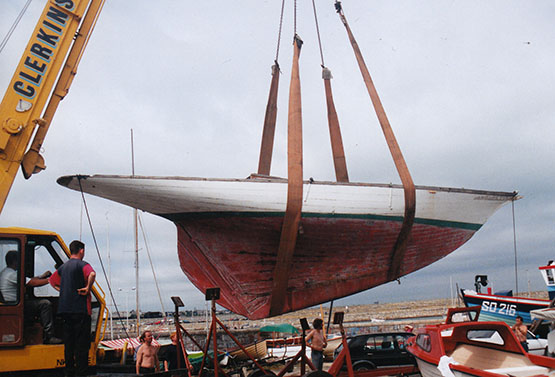
For the rapid yacht design development seen during John Hilditch’s busy years, compare this with the next image. The old-style hull of Peggy Bawn is revealed as she is lifted out of the Coal Harbour Yard in Dun Laoghaire in 1996 for a first attempt at restoration. Later, Hal Sisk took over the project, and it was completed for him by Michael Kennedy of Dunmore East. Photo:W M Nixon
 The new style shape. Although they were built only three years after Peggy Bawn, the Fife-designed Belfast Lough Class I boats had a much more modern hull shape and were primarily racing boats, yet they were required to be well capable of sailing to Scotland and Dublin Bay, and did so
The new style shape. Although they were built only three years after Peggy Bawn, the Fife-designed Belfast Lough Class I boats had a much more modern hull shape and were primarily racing boats, yet they were required to be well capable of sailing to Scotland and Dublin Bay, and did so
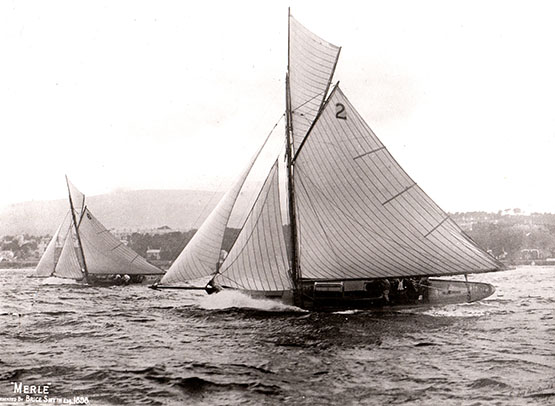 Formidable performers. The Belfast Lough Class I boats Merle (6, Brice Smyth) and Flamingo (2, John Pirrie) racing hard in 1898. Both owner-skippers were members of Carrickfergus SC, and based their boats there. Photo: Courtesy RNIYC
Formidable performers. The Belfast Lough Class I boats Merle (6, Brice Smyth) and Flamingo (2, John Pirrie) racing hard in 1898. Both owner-skippers were members of Carrickfergus SC, and based their boats there. Photo: Courtesy RNIYC
In order to meet this demand, John Hilditch was able to expand his new boatyard at an extraordinary pace. Even then, he couldn’t keep up with demand, such that one new Belfast Lough class, the Linton Hope-designed lifting-keel 17ft LWL Jewel Class of 1898, had to be built in Chester in England. And at the same time, the fishing-boat builder James Kelly of Portrush on the North Coast found that yacht-building to supply the new craze was much more lucrative than producing his own variant of the classic Greencastle yawl for fishermen on both the Irish and Scottish coasts, and he went into yacht-building both for Belfast Lough and Dublin Bay.
But in terms of overall contribution to the transformation of Belfast Lough sailing, John Hilditch was very much in a league of his own. So much so, in fact, that noted international classic sailing polymath Iain McAllister got to thinking last winter that even though no trace whatsoever now remains of this once famous yard, it was time and more for John Hilditch’s work to be celebrated, and how better than a Hilditch Regatta during 2016 to tie in with other Belfast Lough sailing celebrations?

It’s a great idea which seemed almost too good to be true. But thanks to quiet work behind the scenes, most notably by Wendy Grant who recently became Commodore of Carrickfergus Sailing Club neatly in time to hold the top post during the 150th celebrations (she’s the mother of renowned offshore navigator Ian Moore), plus a special sub-committee in RUYC which likewise holds to the notion that the early stages of good work are best done by stealth, a programme is emerging which will keep all organising parties happy while providing participants with a manageable user-friendly schedule.
It has all become viable during this past week thanks to the confirmation that the more distantly-located significant classic boats of the Hilditch oeuvre – Peggy Bawn of 1894, Tern of the 1897 Belfast Lough Class I, the Howth 17s of 1898, and Trasnagh, the Island Class yawl of 1913 – all hope to be in Belfast Lough towards the end of June 2016, where numbers will be further swollen by the Hilditch-built Royal North of Ireland YC Fairy Class of 1902, together with some of their sister-ships from Lough Erne.
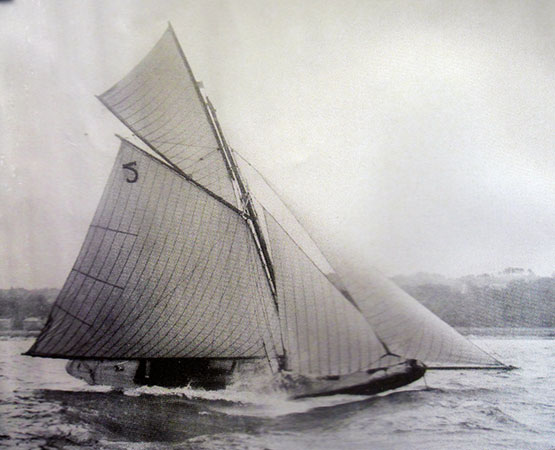
The Hilditch-built Tern in a breeze of wind on Belfast Lough, 1898
Tern in a breeze of wind at St Tropez, September 2015.
In addition, the fleet will be increased by other classics of every type, coming together to wish the Hilditch boats well at this special time. And there’ll be a goodly contingent of Irish Sea Old Gaffers which will be heading towards the big event on Belfast Lough in late June by way of the Old Gaffers Rally at Portaferry in the entrance to Strangford Lough from June 17th to 19th.
But before getting carried away by anticipation of all this festivity, let us remember that this week’s thoughts were introduced by a precautionary reminder that the boat-building trade is no bed of roses. So just what did go wrong, that the much-admired Hilditch yard faced closure before the end of 1913, with the man himself dead – perhaps broken-hearted – before the end of 1914?
There seem to be a number of explanations, all of which combine to explain the sudden demise of a great enterprise. The incredible rate of economic expansion in Belfast – which had been accelerating virtually every year since around 1850 – seems to have first shown significant signs of slackening in 1910. The greater Belfast economy did continue to expand in the broadest sense, but the rate of expansion was now slowing.
During the rapid growth years, John Hilditch was able to meet demand, but regardless of the underlying economic patterns, by 1910 his market was beginning to reach saturation levels. If people had continued to change their boats every three years or so – as they’d anticipated doing when the Belfast Lough One Design Association was established in 1896 – then an artificial demand might have been maintained. But people were beginning to realise that a good one design boat was good for much longer than a mere three years. In fact, some argued that a class was only bedded in after three years. So the number of new boats being ordered dried to a trickle.
Yet those boats that were being ordered became individually larger. When the Alfred Mylne-designed 39ft Belfast Lough Island Class yawls began to be conceptualised as the world’s first true cruiser-racer one designs in 1910, they would be far and away the biggest and most expensive one designs Hilditch had yet built. He held out for a price of £350 per boat, but the potential owners – hard-headed Belfast businessmen determined to drive a tough bargain and not to be seen to weaken – wouldn’t budge beyond £345.
In those days, yacht-building was simply priced by overall length, so Hilditch resigned himself to accepting the £345 by agreeing to build a boat with a slightly shorter bow. For all parties, it was a case of cutting off one’s nose off to spite one’s face. The new Island Class yawls were handsome enough. But with a longer bow, they’d have been beautiful.
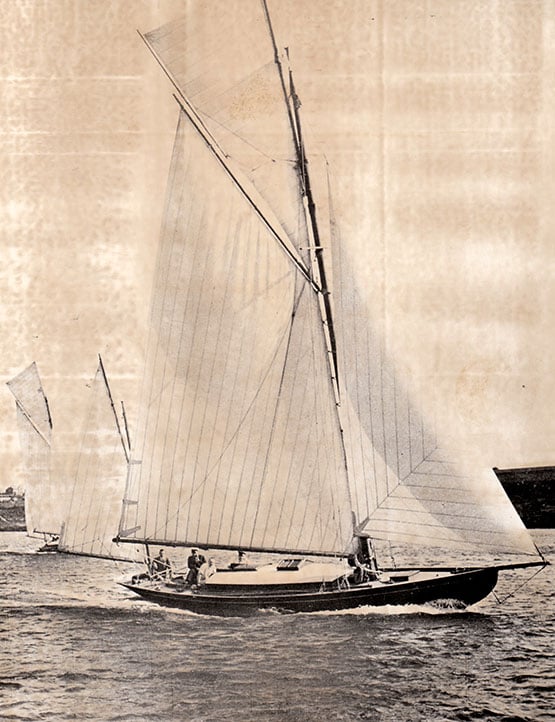 The island Class yawl Trasnagh, seen here in her first season of 1913, is believed to be the last boat to have been built by John Hilditch. Photo: Courtesy RNIYC
The island Class yawl Trasnagh, seen here in her first season of 1913, is believed to be the last boat to have been built by John Hilditch. Photo: Courtesy RNIYC
The last of them, Trasnagh herself in 1913, was the last boat to come out of a formerly great yard rapidly tumbling towards extinction. The times were restless politically as well as economically, so it wasn’t a good time to rely on building pleasure boat for a living. And apart from the saturation of the market and the financial demands of building the relatively large Island Class boats, sailing was no longer attracting the same number of newcomers, as rival interests such as motor cars and aeroplanes were taking away many potential enthusiasts,
Yet ironically, had John Hilditch been able to hang on for just another year into the beginning of the Great War of 1914-18, a slew of war work for the Admiralty would have given his yard a new lease of life. But it was not to be. The yard was gone. And soon, so too was the man himself.
But the boats live on. One hundred and two years after John Hilditch’s death, boats that he created are still sailing the seas, and their assembly in Belfast Lough from June 22nd 2016 onwards will be a reminder that, once upon a time, on a site long since covered by Carrickfergus’s re-developed waterfront, John Hilditch and his team built nearly a hundred fine yachts, the best of which have well stood the test of time. All that together with the 150th Anniversaries of two remarkable sailing clubs. For sure, late June on Belfast Lough is going to be one very special time.
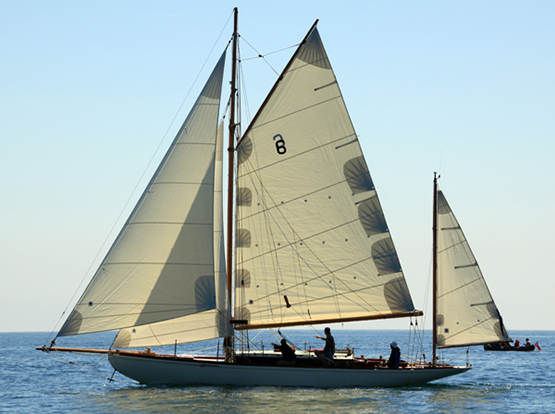
Trasnagh restored for her Centenary in 2013



























